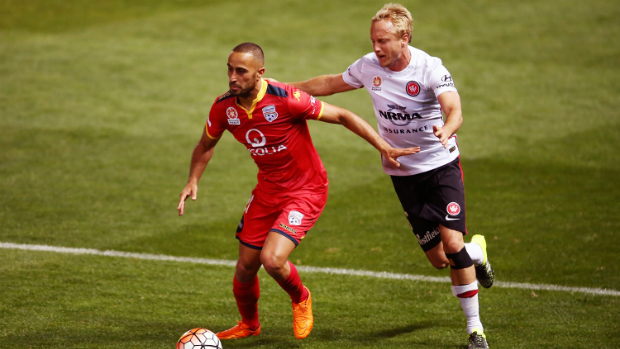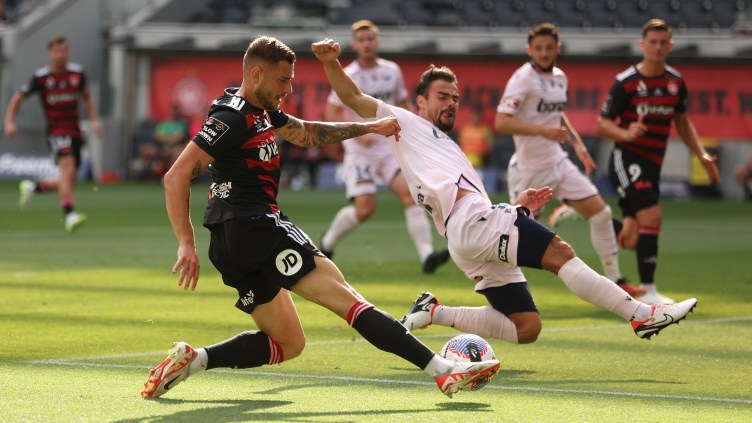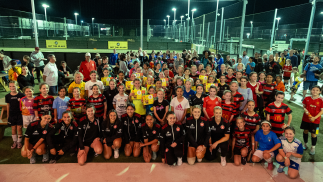The Wanderers secured their first point of the season on Friday after a well-deserved 1-1 draw with Adelaide.
Whilst both sides could consider this to be two points lost for different reasons, the sheer number of opportunities missed by the Wanderers will leave the team the more frustrated of the two.
However, as Tony Popovic lauded after the game, this was a performance of real promise from the Wanderers, one in which they edged their opponents in most key areas of the match.
Coopers Stadium is not a happy hunting ground for the Red & Black. It’s a venue in which Adelaide can decimate most teams into chasing shadows through their expansive passing football, but prior to last night’s visit the Wanderers had picked up just three points from a possible 15.
Wanderers edge battle of the press
Out of the ten Hyundai A-League sides, perhaps none can attest to a strong commitment to possession football than Adelaide United. Deservedly or not, they’ve evolved into the league’s poster boys for the beautiful side of the game, and one of the key building blocks for Adelaide’s way of operating is their ability to navigate the ball through lines of pressure.
Adelaide are renowned for predominantly playing the ball out from the back but they found themselves going long from deep areas due to some well-executed pressing from the Wanderers.
Forcing three turnovers inside the first five minutes, the Wanderers settled into an effective pressing pattern where the front four would push forward towards the man in possession and their immediate passing options.
This set the tone for the first half where the Wanderers nullified the threat of Adelaide’s passing game at the source. Although stand in goalkeeper John Hall made some impressive saves for United, his distribution, such a key part of the Reds’ game plan, was off the mark. Hall was forced into un-Adelaide like long balls from defence, which made up 59% of his distribution (we’ll compare this key area of this game with the distribution of Andrew Redmayne later).
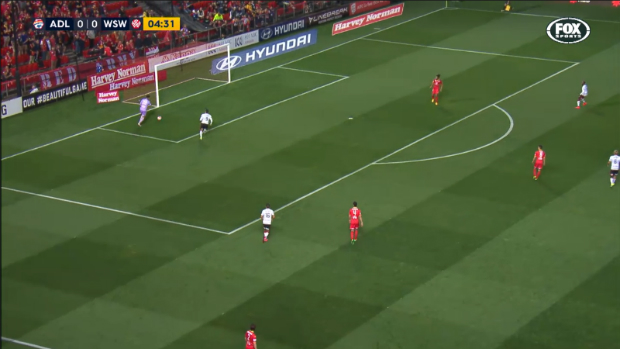
The Wanderers attacking quartet pressed high up the park and forced a number of turnovers in possession.
Adelaide were muffled and disorganised, and struggled to play the ball through the centre of the pitch to release key man Marcelo Carrusca in between the Wanderers defensive lines. In order to restrict the metronomic influence of Adelaide’s Isaias, Tony Popovic employed a 4-4-2 formation without the ball. This allowed for a more compact and disciplined structure in midfield, but also ensured that the side were able to quickly initiate the next wave of pressure should Adelaide rebuild through the goalkeeper.
As shown below, Piovaccari and Nichols would sit off the two Adelaide centre-halves Malik and McGowan, ensuring neither could find Isaias (circled) with an easy ball to feet.
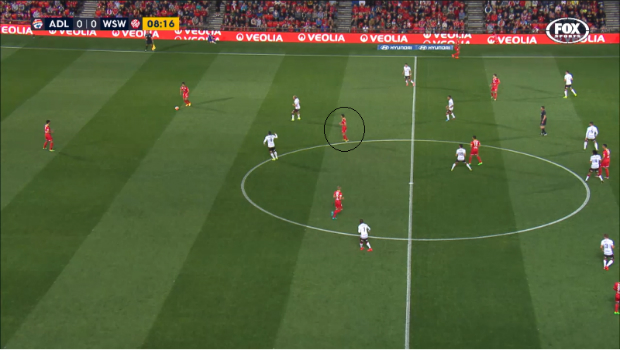
The Wanderers reverted to 4-4-2 without the ball, with Mitch Nichols dropping alongside Piovaccari as a second striker.
In this example, Adelaide possession broke down when McGowan lofted another un-Adelaide-like ball over the top of the Wanderers back four but similar phases were replicated on countless occasions through the first half.
This isn’t to say this played completely into the Wanderers’ hands: United were still a considerable threat from these switches of play and from the direct aerial ball. Last season, this was a key tactic they used effectively to counter-act the pressing game of their opponents, through long diagonal passes in behind to wingers.
But apart from Scott Neville’s poor positioning in the build-up to the Adelaide goal, the Wanderers back four were collectively excellent in plugging this threat with Jamieson and Topor-Stanley winning each aerial challenge contested whilst Neville was impressive himself, winning 87% of his aerial duels.
As a result, the Wanderers were allowed to dictate the opening exchanges. After generating turnovers, they were generally first to the second ball and were fluid and clinical in transition, forging two clear-cut opportunities and creating several other key chances in prime positions in the opening stanza.
Although Adelaide had gone ahead through Andreu’s own goal, it was the Reds who found themselves on the back foot for the best part of the game. This can be attributed to how effectively and more often the Wanderers were able to break the Adelaide lines of pressure and counter-attack, primarily though the excellent Mitch Nichols, who made four key passes (a game high).
Previously, after the Westfield FFA Cup defeat to Perth, we noted how in stark comparison to previous iterations of Popovic’s team, the side would look to both retain spells of possession and build attacks from the goalkeeper, and indeed from goal kicks themselves.
This rang true in the side’s performance against United and their ability to break lines of pressure without resorting to the forced long-ball option they had pressured the Reds defence into, will no doubt be one of the most positive signs shown mentioned by Popovic after the game.
A large factor in this was the performance of the Wanderers’ double-pivot, Andreu and Dimas, and the variety of movement ahead of them from the team’s front four. The ability of both Spaniards to find space deep in their own half and turn to play forward meant that the Wanderers were able to utilise the most from their 42% possession of the ball, in contrast to Adelaide, who were far more ponderous in possession: something Reds defender Dylan McGowan admitted after the game.
“We stopped passing the ball with purpose at the back end of the first half and then the second half we looked a bit toothless when we had possession. It’s something we have to work on. 1-0 is never enough in the A-League.”
This could be further highlighted by the performance of Andrew Redmayne, who unlike his opposite number John Hall, played just 33% of his distribution long. The Wanderers custodian made 20 fewer passes than Hall but maintained a top-class passing accuracy of 91%, providing his team with a greater possible avenue of maintaining possession.
These factors combined and were captured neatly in the 34th minute when the Wanderers went from their own box to their opponent’s. The team is growing in confidence in this regard and successfully performed this action several times during pre-season. It’s a pleasure to watch this fresh aspect of the Wanderers’ game unfurl quite so smoothly given that it can take a great number of months fostering and eventually perfecting.
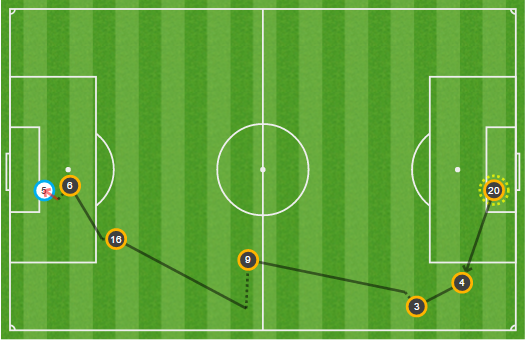
End to end: Mitch Nichols’ chance in the 34th minute
As the team reinvents itself, the Wanderers’ have shown against Adelaide that they are becoming increasingly adept at beating the pressing game of their opponents themselves, in a fashion that is emphasised around a more considered, progressive use of possession.
You feel that this well-crafted groundwork at the back will lay the platform for the floodgates to open in front of goal sooner or later.
